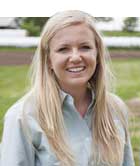Life after alfalfa winterkill |
| By Sydney Sleep |
|
|
|
Lack of snow cover and drastic changes in temperature in parts of the country have turned alfalfa stands from green to brown. In South Dakota, damage has occurred in areas of fields where ice sheets formed, water ponded, there was poor drainage, and was not enough snow cover to insulate alfalfa against extreme temperatures. “Late harvested stands that are 3 or more years old are showing more damage than younger ones under moderate management,” says Karla Hernandez, South Dakota State University extension forages field specialist. In SDSU extension’s newsletter, iGrow, Hernandez gives a few options to improve forage production after experiencing significant winterkill. One approach is to interseed more alfalfa in thin spots of fields planted last year. For older alfalfa stands, autotoxicity can make interseeding alfalfa very risky unless it’s an area where a complete kill occurred. Interseeding forage grasses or clovers will fill the gaps left by winterkilled alfalfa, prevent weed competition, and provide good-quality forage. Red clover can help prolong the life of alfalfa by about two years. Small grains and annual cool-season grasses can provide high-quality forage fast and prolong stand life for one year. Interseeding perennial grasses such as orchardgrass, timothy, or tall fescue can enhance stands for two or more years depending on production, but may take longer to fully establish than annual grasses. Hernandez recommends evaluating alfalfa stands when the new spring growth is about 6 inches tall. Start by counting all stems longer than 2 inches within a 1 square foot area. Healthy stands will have more than 55 stems per square foot, regardless of stand age. If stem count is below 40 stems per square foot, consider interseeding. If fields have more than 50 percent alfalfa loss, Hernandez notes that starting over may be the best solution. However, fields with less than 50 percent alfalfa loss may be worth salvaging for one additional year of production.  Sydney Sleep Sydney Sleep was the 2016 Hay & Forage Grower summer editorial intern and is a junior at South Dakota University. |

